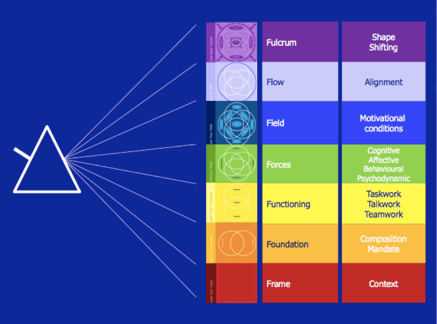Our last leadership lab of 2018 was hosted by Fluvius who has taken its recent merger (between Eandis en Infrax) as an opportunity to introduce a new way of working centered around shared leadership and teamwork. A huge undertaking for an organization with more than 5000 employees who have been used to “just follow orders” until now, as Kim Sluyts shared with the group. “This transition isn’t taking place overnight: the ‘why’ needs to be clear and compelling for different groups, your CEO needs to be a strong supporter, and your teams will need a toolkit to work and develop as a team.”
What could this toolkit look like? Fluvius has experimented with inspiration days and a team scan to let teams determine for themselves what their needs are. We were eager to find out what prof. Drikus Kriek, vice dean for pedagogy at IEDC-Bled School of Management, could add to this mix.
3 stories to reveal potential and traps
All his academic life Drikus – an Afrikaner who lives and works in Slovenia – has tried to wrap his head around the levers to increase a team’s performance (in the broadest sense). He uses the metaphor of a classic prism to describe teams and the work to be done by the leader. For him, teams do not develop linearly, and factors contributing to team performance do not stack up in layers. Things happen instantaneously, and combined they make up the white light. Leaders need to look at all angles simultaneously.
Get beyond the usual suspects
Coming up with a list of driving forces for high performing teams was an easy task for the 12 Leadership Development professionals gathered in our lab. However, according to Drikus, we didn’t get beyond the usual suspects. He mapped our input onto what he considers to be four basic building blocks. First, you have the context that provides the frame – it determines the making of a team and level of support. At the foundational level the team’s mandate and composition determine success. Next there is the team’s functioning – with questions to be addressed around task, talk and teamwork – and finally there are unconscious forces that create common mental models at the cognitive, affective and behavioral level.
He challenged us to look beyond those basic conditions, triggered by the Ringerwald experiment. How could we explain that in a team of 8, the average force per team member dropped to 34 newtons compared to 54 in a 3-member team and 63 when the task was performed by one individual? Drikus argues that more attention should go to the motivational conditions and we should think of teams as a mindspace that individuals either step into or not.
Teams are mindspaces
What minimum conditions can we put in place for people to pick up the work and be motivated in teams? Drikus gave us a rich list of possible items to work with: make the link with measurable individualized outcomes, ensure interdependence (‘the team needs me, and I need the team’), manage perceptions of equity or fairness, make clear which (small) progress has been made towards meaningful goals, provide support & safety, etc. More importantly than coming to an exhaustive list of motivating conditions and checking off those boxes was Drikus’ overarching idea that teams are mindspaces where people’s intents come together. As a team leader you want to co-create a space that people can step into and follow. This requires safety and buy-in towards the intent. To him, leadership is a connection of moments in which there is opportunity to create meaning to the members. And creating meaning can mean different things for different people.
With that, the group realized that leading teams is as complex as a prism. Or more positively formulated, there are many entries to working with teams. Moving beyond the basic conditions, it is a matter of shifting from me to meaning. Drikus concluded with the thought: “If you can cater for the different conditions that we discussed, you have a driving force for shared leadership.”

This Leadership Lab is part of the Connect program of our Expertise Center Leadership. Want to know more?



